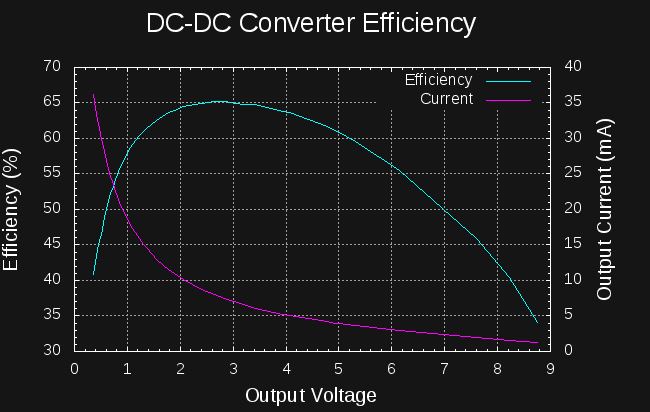I must have figured this out while sleeping, because when I woke this morning, I knew I could use the cell discharge tester to measure the DC-DC converter efficiency. The discharge tester is an adjustable current load. By connecting this load to the output of the DC-DC converter and manually sweeping the current, I could record the converter efficiency as a function of output voltage.

The plot shows efficiency and output current vs output voltage for the homebrew converter tuned to draw 10.7mA from a 3V source. A 1.7Ah LiSOCl2 cell can supply this current without any decrease in capacity.
The efficiency peaks at 65% between about 2.5 and 3.5V output. This is a good match to charging a series battery of two AA NiCd cells (nominal 2.4V). To ensure good NiCd efficiency, I'll want to limit the cells to 70% charged, so I will probably use two sets of NiCd's in parallel, making a 2S2P pack of 2.4V / 2Ah capacity.
I ordered some 1000mAh NiCd cells, since I haven't had any around here in over a decade.
The efficiency of the converter is not very good compared to commercial offerings, but the input current is easily adjusted to a fixed value, an odd requirement for a power supply. I am not sure how easy this is to do with commercial switcher offerings. Does anybody know about this?
I will have to re-test this converter with a higher input current, because if the efficiency curve is the same, this converter is unsuitable for charging capacitors to 14V. At only 9V output, the efficiency has dropped to below 35%. The efficiency peak around 2.5V might make it OK for charging 2.7V capacitors in parallel (they would then be connected in series once charged). Even then, the steep drop-off of efficiency at low voltages isn't very good.
I still have to investigate commercial DC-DC converters for charging the supercapacitors.
The problem with the 10.7mA current is that it would take a week to get all the energy out of an LiSOCl2 cell at this rate. The cell is rated for 10mA continuous/50mA pulse, but I'm not sure how far I'm willing to push it. Going to 30mA would drain the cell in 57 hours, which seems more reasonable.
 Ted Yapo
Ted Yapo
Discussions
Become a Hackaday.io Member
Create an account to leave a comment. Already have an account? Log In.